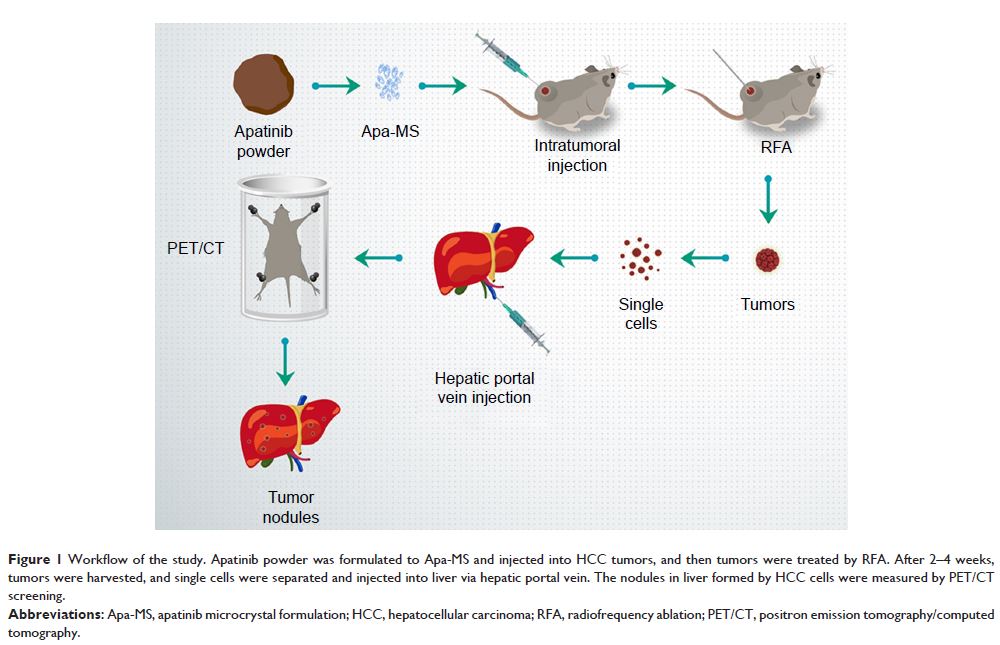108899
论文已发表
注册即可获取德孚的最新动态
IF 收录期刊
- 3.4 Breast Cancer (Dove Med Press)
- 3.2 Clin Epidemiol
- 2.6 Cancer Manag Res
- 2.9 Infect Drug Resist
- 3.7 Clin Interv Aging
- 5.1 Drug Des Dev Ther
- 3.1 Int J Chronic Obstr
- 6.6 Int J Nanomed
- 2.6 Int J Women's Health
- 2.9 Neuropsych Dis Treat
- 2.8 OncoTargets Ther
- 2.0 Patient Prefer Adher
- 2.2 Ther Clin Risk Manag
- 2.5 J Pain Res
- 3.0 Diabet Metab Synd Ob
- 3.2 Psychol Res Behav Ma
- 3.4 Nat Sci Sleep
- 1.8 Pharmgenomics Pers Med
- 2.0 Risk Manag Healthc Policy
- 4.1 J Inflamm Res
- 2.0 Int J Gen Med
- 3.4 J Hepatocell Carcinoma
- 3.0 J Asthma Allergy
- 2.2 Clin Cosmet Investig Dermatol
- 2.4 J Multidiscip Healthc

一种新的阿帕替尼微晶制剂增强了射频消融治疗肝细胞癌的效果
Authors Xie H, Tian S, Yu H, Yang X, Liu J, Wang H, Feng F, Guo Z
Received 8 February 2018
Accepted for publication 20 March 2018
Published 31 May 2018 Volume 2018:11 Pages 3257—3265
DOI https://doi.org/10.2147/OTT.S165000
Checked for plagiarism Yes
Review by Single-blind
Peer reviewers approved by Dr Federico Perche
Peer reviewer comments 2
Editor who approved publication: Dr William Cho
Introduction: Radiofrequency ablation (RFA) is the foremost treatment option for
advanced hepatocellular carcinoma (HCC), however, rapid and aggressive
recurrence of HCC often occurs after RFA due to epithelial–mesenchymal
transition process. Although combination of RFA with sorafenib, a molecular
targeted agent, could attenuate the recurrence of HCC, application of this
molecular targeted agent poses a heavy medical burden and oral administration
of sorafenib also brings severe side effects.
Materials and
methods: In this study, we prepared an
apatinib microcrystal formulation (Apa-MS) that sustainably releases apatinib,
a novel molecular targeted agent, for advanced HCC treatment. We injected
apatinib solution or Apa-MS into subcutaneous HCC tumors.
Results: It was found that Apa-MS exhibited slow apatinib release in vivo
and in turn inhibited the epithelial–mesenchymal transition of HCC cells for
extended time. Moreover, in rodent HCC model, Apa-MS enhanced the antitumor
effect of RFA treatment.
Conclusion: Based on these results, we conclude that Apa-MS, a slow releasing
system of apatinib, allows apatinib to remain effective in tumor tissues for a
long time and could enhance the antitumor effect of RFA on HCC.
Keywords: apatinib microcrystals, radiofrequency ablation, sustained
releasing behavior, long-acting efficiency, epithelial–mesenchymal transition,
interventional therapy
